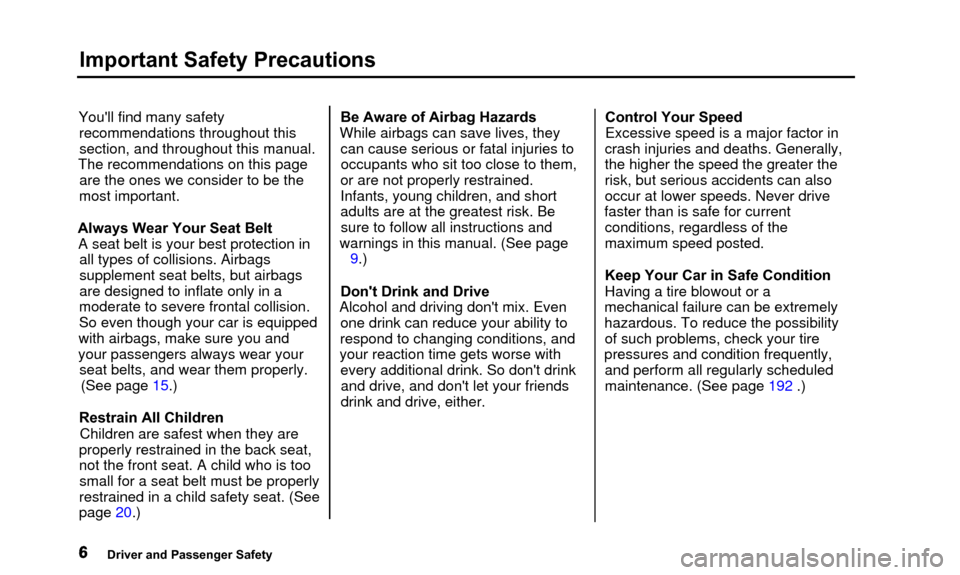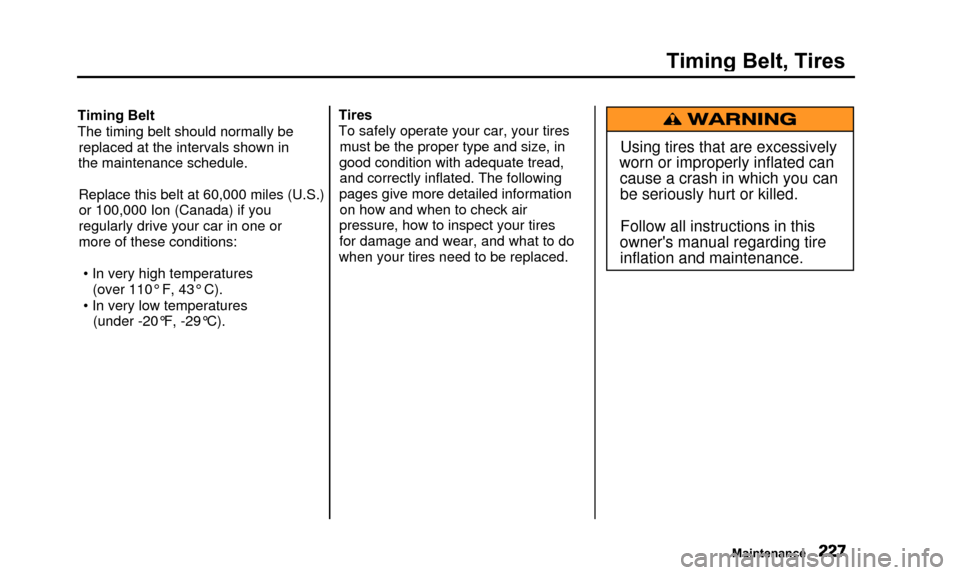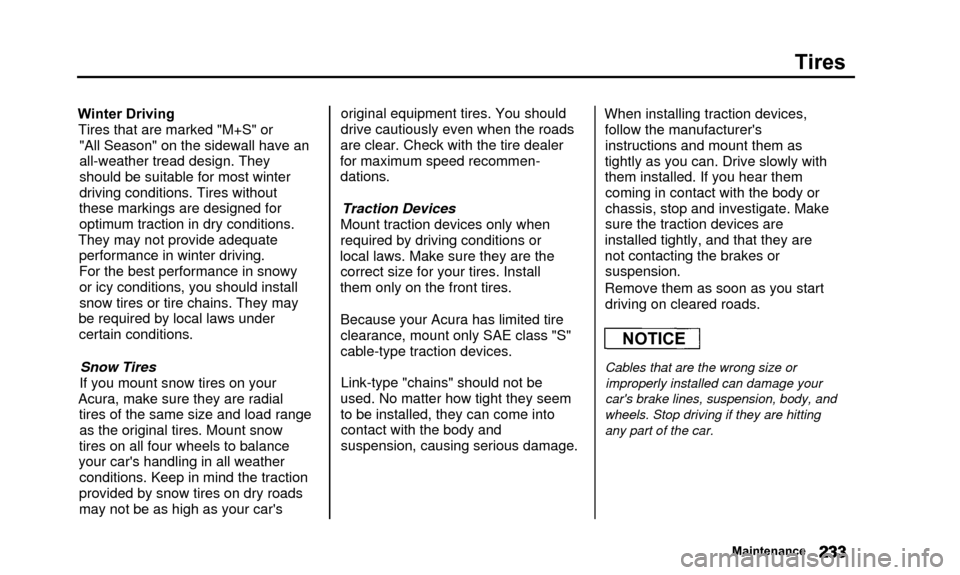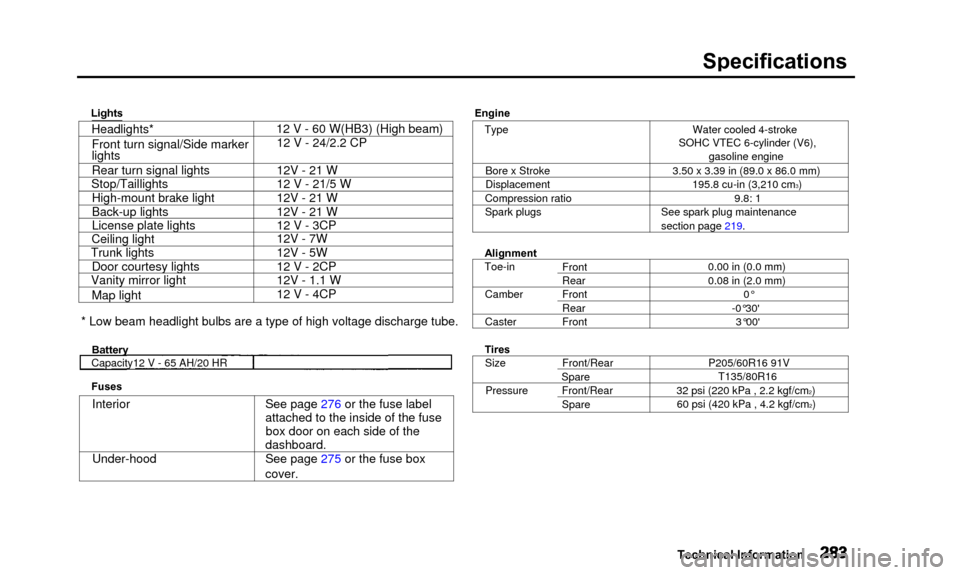tire type Acura TL 2000 3.2 Owner's Manual
[x] Cancel search | Manufacturer: ACURA, Model Year: 2000, Model line: TL, Model: Acura TL 2000Pages: 311, PDF Size: 3.05 MB
Page 9 of 311

Important Safety Precautions
You'll find many safetyrecommendations throughout thissection, and throughout this manual.
The recommendations on this page are the ones we consider to be the
most important.
Always Wear Your Seat Belt A seat belt is your best protection in all types of collisions. Airbags
supplement seat belts, but airbags
are designed to inflate only in a
moderate to severe frontal collision.
So even though your car is equipped
with airbags, make sure you and
your passengers always wear your seat belts, and wear them properly. (See page 15.)
Restrain All Children Children are safest when they are
properly restrained in the back seat,
not the front seat. A child who is too small for a seat belt must be properly
restrained in a child safety seat. (See page 20.) Be Aware of Airbag Hazards
While airbags can save lives, they can cause serious or fatal injuries tooccupants who sit too close to them,
or are not properly restrained.
Infants, young children, and short
adults are at the greatest risk. Be sure to follow all instructions and
warnings in this manual. (See page 9.)
Don't Drink and Drive
Alcohol and driving don't mix. Even one drink can reduce your ability to
respond to changing conditions, and
your reaction time gets worse with every additional drink. So don't drinkand drive, and don't let your friends
drink and drive, either. Control Your Speed
Excessive speed is a major factor in
crash injuries and deaths. Generally,
the higher the speed the greater the
risk, but serious accidents can also
occur at lower speeds. Never drive
faster than is safe for current conditions, regardless of the
maximum speed posted.
Keep Your Car in Safe Condition
Having a tire blowout or a
mechanical failure can be extremely
hazardous. To reduce the possibility of such problems, check your tire
pressures and condition frequently, and perform all regularly scheduledmaintenance. (See page 192 .)
Driver and Passenger Safety
Page 230 of 311

Timing Belt, Tires
Timing Belt
The timing belt should normally bereplaced at the intervals shown in
the maintenance schedule.
Replace this belt at 60,000 miles (U.S.)or 100,000 Ion (Canada) if you
regularly drive your car in one or
more of these conditions:
• In very high temperatures (over 110° F, 43° C).
• In very low temperatures (under -20°F, -29°C). Tires
To safely operate your car, your tires
must be the proper type and size, in
good condition with adequate tread, and correctly inflated. The following
pages give more detailed information on how and when to check air
pressure, how to inspect your tires
for damage and wear, and what to do
when your tires need to be replaced.
Using tires that are excessively
worn or improperly inflated can cause a crash in which you canbe seriously hurt or killed.
Follow all instructions in this
owner's manual regarding tire inflation and maintenance.
Maintenance
Page 235 of 311

Tires
Installing improper tires on your
car can affect handling and
stability. This can cause a crash in which you can be seriously
hurt or killed.
Always use the size and type of
tires recommended in this owner's manual.
It is best to replace all four tires at
the same time. If that is not possible or necessary, then replace the two
front tires or the two rear tires as a
pair. Replacing just one tire can seriously affect your car's handling. The ABS works by comparing the
speed of the wheels. When replacing
tires, use the same size originally supplied with the car. Tire size and
construction can affect wheel speed
and may cause the system to work inconsistently.
If you ever need to replace a wheel,
make sure you use an identical style
aluminum alloy wheel that originally
came on your Acura. Replacement
wheels are available at your Acura dealer. Wheels and TiresWheel:
16x61/2JJ
Tire: P205/60R16 91V
See page 284 for information about
DOT Tire Quality Grading.
Maintenance
Page 236 of 311

Tires
Winter DrivingTires that are marked "M+S" or "All Season" on the sidewall have an
all-weather tread design. They
should be suitable for most winter
driving conditions. Tires without
these markings are designed for optimum traction in dry conditions.
They may not provide adequate performance in winter driving.
For the best performance in snowyor icy conditions, you should install
snow tires or tire chains. They may
be required by local laws under certain conditions.
Snow Tires
If you mount snow tires on your
Acura, make sure they are radial tires of the same size and load rangeas the original tires. Mount snow
tires on all four wheels to balance
your car's handling in all weather conditions. Keep in mind the traction
provided by snow tires on dry roads
may not be as high as your car's original equipment tires. You should
drive cautiously even when the roads
are clear. Check with the tire dealer
for maximum speed recommen- dations.
Traction Devices
Mount traction devices only when
required by driving conditions or
local laws. Make sure they are the correct size for your tires. Install
them only on the front tires.
Because your Acura has limited tire
clearance, mount only SAE class "S"
cable-type traction devices.Link-type "chains" should not be
used. No matter how tight they seem
to be installed, they can come into contact with the body andsuspension, causing serious damage. When installing traction devices,
follow the manufacturer'sinstructions and mount them as
tightly as you can. Drive slowly with
them installed. If you hear them coming in contact with the body or
chassis, stop and investigate. Make
sure the traction devices are
installed tightly, and that they are
not contacting the brakes or suspension.
Remove them as soon as you start driving on cleared roads.
Cables that are the wrong size or
improperly installed can damage your
car's brake lines, suspension, body, and
wheels. Stop driving if they are hitting
any part of the car.
Maintenance
NOTICE
Page 280 of 311

Emergency Towing
If your car needs to be towed, call a
professional towing service or, if you
belong to one, an organization that
provides roadside assistance. Never
tow your car behind another vehicle
with just a rope or chain. It is very dangerous.
There are three popular types of professional towing equipment:
Flat-bed Equipment — The operator
loads your car on the back of a truck.
This is the best way to transport
your Acura.
Wheel-Lift Equipment — The tow
truck uses two pivoting arms that go
under the tires (front or rear) and lift
them off the ground. The other two
tires remain on the ground. This is an acceptable way to tow your
Acura.
Sling-type Equipment — The tow
truck uses metal cables with hooks on the ends. These hooks go around
parts of the frame or suspension and
the cables lift that end of the car off
the ground. Your car's suspension and body can be seriously damaged.
This method of towing is unacceptable.
If your Acura cannot be transported
by flat-bed, it should be towed by
wheel-lift equipment with the front
wheels off the ground. If, due to damage, your car must be towed
with the front wheels on the ground, do the following.
• Release the parking brake.
• Start the engine.
• Shift to D5, then to N.
• Turn off the engine.
Improper towing preparation will
damage the transmission. Follow the
above procedure exactly. If you cannot
shift the transmission or start theengine, your car must be transported
with the front wheels off the ground.
• With the front wheels on the ground, it is best to tow the car no
farther than 50 miles (80 km), and
keep the speed below 35 mph (55
km/h).
CONTINUED
Taking Care of the Unexpected
NOTICE
Page 286 of 311

Specifications
Lights
TypeBore x Stroke
Displacement
Compression ratio
Spark plugs
Alignment
Toe-in Camber
Caster
Tires Size
Pressure Front
Rear
Front
Rear
Front
Front/Rear
Spare Front/Rear
Spare Water cooled 4-stroke
SOHC VTEC 6-cylinder (V6), gasoline engine
3.50 x 3.39 in (89.0 x 86.0 mm) 195.8 cu-in (3,210 cm
3)
9.8: 1
See spark plug maintenance
section page 219.
0.00 in (0.0 mm)
0.08 in (2.0 mm)0°
-0°30' 3°00'
P205/60R16 91V T135/80R16
32 psi (220 kPa , 2.2 kgf/cm
2)
60 psi (420 kPa , 4.2 kgf/cm2)
Technical Information
Headlights* Front turn signal/Side marker
lights
Rear turn signal lights
Stop/Taillights
High-mount brake light
Back-up lights
License plate lights
Ceiling light
Trunk lights
Door courtesy lights
Vanity mirror light
Map light 12 V - 60 W(HB3) (High beam)
12 V - 24/2.2 CP
12V - 21 W
12 V - 21/5 W
12V - 21 W
12V - 21 W
12 V - 3CP
12V - 7W
12V - 5W
12 V - 2CP
12V - 1.1 W
12 V - 4CP
* Low beam headlight bulbs are a type of high voltage discharge tube.
Battery
Fuses
Interior
Under-hood See page 276 or the fuse label
attached to the inside of the fuse
box door on each side of the
dashboard.
See page 275 or the fuse box
cover.
Capacity12 V - 65 AH/20 HR
Engine
Page 297 of 311

Warranty Coverages
U.S. Owners
Your new Acura is covered by these
warranties:
New Car Limited Warranty — covers
your new vehicle, except for the battery, emissions control systemsand accessories, against defects in
materials and workmanship.
Emissions Control Systems Defects
Warranty and Emissions
Performance Warranty — these two
warranties cover your vehicle's emis- sions control systems. Time, mileage,
and coverage are conditional. Please
read the warranty manual for exact information.
Original Equipment Battery Limited
Warranty — this warranty gives up
to 100 percent credit toward a
replacement battery.
Seat Belt Limited Warranty — a seat
belt that fails to function properly is covered for the useful life of the
vehicle.
Rust Perforation Limited Warranty — all exterior body panels are
covered for rust-through from the
inside for the specified time period
with no mileage limit.
Accessory Limited Warranty — Genuine Acura Accessories are
covered under this warranty. Time
and mileage limits depend on the
type of accessory and other factors. Please read your warranty manual
for details.
Replacement Parts Limited Warranty — covers all Genuine
Acura replacement parts against defects in materials and workman-ship. Replacement Battery Limited
Warranty — provides prorated
coverage for a replacement battery
purchased from an Acura dealer.
Replacement Muffler Lifetime
Limited Warranty — provides
coverage for as long as the pur-
chaser of the muffler owns the car.
Restrictions and exclusions apply to all these warranties. Please read the
2000 Acura Warranty Information
booklet that came with your car for
precise information on warranty
coverages. Your Acura's original
tires are covered by their manufacturer. Tire warranty infor-
mation is in a separate booklet.
Canadian Owners
Please refer to the 2000 Warranty
Manual that came with your car.
Warranty and Customer Relations
Page 308 of 311

Index
Safety Defects, Reporting*.................... 295
Safety Features................................ 7Airbags........ ................................ .. 9
Door Locks......................................... . 10
Head Restraints......... ............................. 10
Seat Belts.............................. .. 8
Seats & Seat-Backs......... ............. 10
Safety Labels, Location of......... ............. 50
Safety Messages................................ ii
Seat Belt, Additional Information. ..... 40
Lap/Shoulder Belt...................... 40
Seat Belt Maintenance............ 42 Seat Belt System Components... 40
Seat Belts...................................... .. 8
Cleaning.......... .............................. 249
Maintenance......... ....................... 42
Reminder Light and Beeper......... .............................. . 54
System Components.................... 40
Tether Attachment Points.......... .. 39
Use During Pregnancy.................... 18
Seats, Adjusting the......... ............. 89
Security System.......... ...................... 143
Serial Number.............................. 280
Service Intervals.......... .................... 192
Service Manual*.......... .................... 297Service Station Procedures.........
... 146
Setting the Clock.......... ............ 100
Shifting The Automati c
Transmission.............................. 162
Shift Lever Position Indicator.......... .. 162
Side Airbags.................................... 9, 46
Side Airbag Indicator......... ........... 47
Side Marker Lights, Bulb
Replacement in.............................. 238
Signaling Turns......... ..................... 65
Snow Tires.......... .............................. 233
Solvent-type Cleaners.......... .......... 246
Sound System.............................. 123
Spare Tire Inflating........................................ 254
Specifications.......... .................... 283
Spark Plugs, Replacing.......... .......... 217
Specifications Charts.......... .......... 282
Speed Control.............................. 69
Speedometer......... ........................ 58
SRS, Additional Information.......... 43 Additional Safety Precautions.... 48How Your Airbags Work.......... 43
How Your SRS Indicator Works....................................... . 45SRS Components.........
............. 43
SRS Service......... ..................... 48
SRS Indicator........................................ 45
START (Ignition Key Position).......... 76
Starting the Engine.......... ............ 161
In Cold Weather at High Altitude.......................................... 161
With a Dead Battery.................... 262
Steam Coming from Engine.......... 265 Steering Wheel Adjustment......... ....................... 68
Anti-theft Column Lock......... ........... 75
Stereo Sound System.................... 123
Storing Your Vehicle.................... 243
Sun Visor........................................ 104
Sunglasses Holder...................... 105
Supplemental Restrain t System
Servicing......... .............................. . 48
SRS Indicator.............................. 45
System Components.................... 43
CONTINUED
T
Tachometer......... .............................. . 58